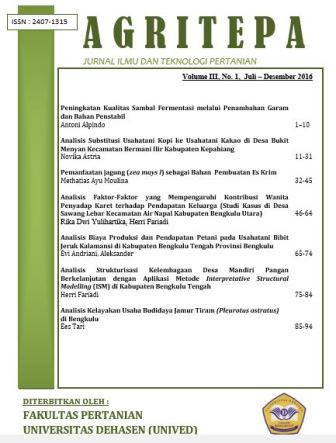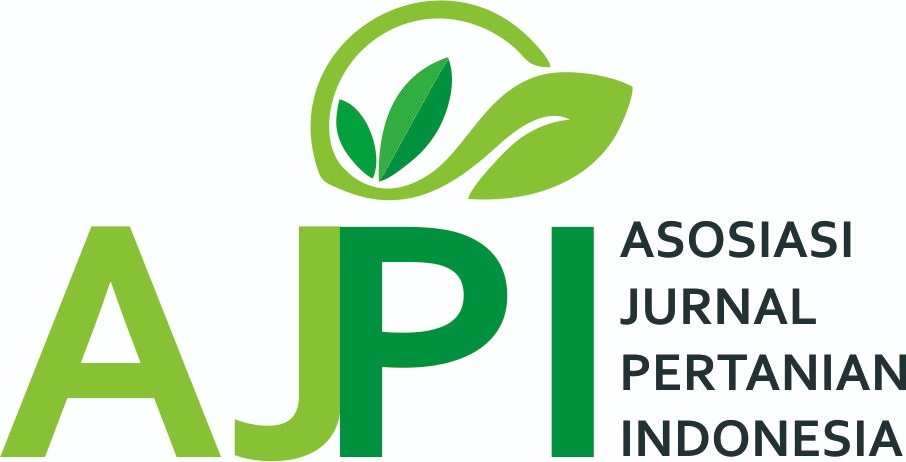Use Of Pcr-Rflp In Halal Authentication Of Meat And Processed Products: Literature Review
Abstract
Produk pangan yang kian kompleks, terutama pada produk daging dapat memicu terjadinya adulterasi, baik sengaja maupun tidak sengaja dengan daging haram. Daging haram (daging babi) yang ada dalam suatu pangan sifatnya adalah haram dikonsumsi oleh umat muslim. Selain itu, produk daging juga banyak beredar di pasaran dengan pelabelan yang kurang jelas. Sehingga, diperlukan suatu teknik yang dapat mendeteksi keberadaan daging haram tersebut dalam suatu matriks pangan. Kajian literatur ini akan membahas terkait penggunaan instrumen Polymerase Chain Reaction-Restriction Fragment Length Polymorphism (PCR-RFLP) dalam autentikasi halal produk daging dari waktu ke waktu, sekaligus membahas kekurangan dan kelebihan teknik PCR-RFLP dalam autentikasi kehalalan produk. Banyak penelitian telah dilakukan untuk menguji efektivitas dari PCR-RFLP dalam membedakan spesies daging hewan dari satu jenis daging hingga beberapa jenis daging.
Downloads
References
Alberts B, Bray D, Hopkin K, Johnson A, Lewis J, Raff M, Roberts K, Walter P. 1999.Fundamentos da Biologia Celular: Uma Introdução à Biologia Molecular da Célula. Porto Alegre: Artes Médicas Sul.
Ali ME, Ahmad MNU, Hossain MM, Sultana S. 2018. Multiplex polymerase chain reaction- restriction fragment length polymorphism assay discriminates of rabbit, rat and squirrel meat in frankfurter products. Food Control. 84:148–158.doi:10.1016/J.FOODCONT.2017.07.030.
Arslan A, Ilhak OI, Calicioglu M. 2006. Effect of method of cooking on identification of heat processed beef using polymerase chain reaction (PCR) technique. Meat Science.72(2):326–330.doi:10.1016/j.meatsci.2005.08.001
Bahagiawati, Reflinur, Santoso TJ. 2015. Teknik PCR Kualitatif untuk Deteksi Produk Rekayasa Genetika Jagung Event BT11 dan GA21. J AgroBiogen. 11(2):65–72. doi:10.21082/jbio.v11n2.2015.p65-72.
Botstein D, White RL, Skolnick M, Davis RW. 1980. Construction of a genetic linkage map in man using restriction fragment length polymorphisms. American Journal of Human Genetics. 32(3):314.
Bottero MT, Dalmasso A. 2011. Animal species identification in food products: Evolution of biomolecular methods. The Veterinary Journal. 190(1):34–38.doi:10.1016/J.TVJL.2010.09.024.
Erwanto Y, Abidin MZ, Muslim EYP, Sugiyono S, Rohman A. 2014. Identification of Pork Contamination in Meatballs of Indonesia Local Market Using Polymerase Chain Reaction-Restriction Fragment Length Polymorphism (PCR-RFLP) Analysis. Asian- Australasian Journal of Animal Sciences.27(10):1487.doi:10.5713/AJAS.2014.14014.
Erwanto Y, Abidin MZ, Rohman A, Sismindari. 2011. PCR-RFLP Using BseDI Enzyme forPork Authentication in Sausage and Nugget Products. Media Peternakan. 34(1):14–14.doi:10.5398/MEDPET.2011.34.1.14.
Erwanto Y, Abidin MZ, Sismindari, Rohman A. 2012. Pig species identification in meatballs using polymerase chain reaction- restriction fragment length polymorphism for Halal authentication. International Food Research Journal. 19(3):901–906.
Fajardo V, González I, López-Calleja I, Martín I, Hernández PE, García T, Martín R. 2006.
PCR-RFLP Authentication of Meats from Red Deer (Cervus elaphus), Fallow Deer (Dama dama), Roe Deer (Capreolus capreolus), Cattle (Bos taurus), Sheep (Ovis aries), and Goat (Capra hircus). Journal of Agricultural and Food Chemistry. 54(4):1144–1150.doi:10.1021/JF051766R.
Gargouri H, Moalla N, Kacem HH. 2021. PCR–RFLP and species-specific PCR efficiency for the identification of adulteries in meat and meat products. European Food Research and Technology 2021 247:9. 247(9):2183–2192.doi:10.1007/S00217-021-03778-Y.
Girish PS, Anjaneyulu ASR, Viswas KN, Shivakumar BM, Anand M, Patel M, Sharma B. 2005. Meat species identification by polymerase chain reaction-restriction fragment length polymorphism (PCR-RFLP) of mitochondrial 12S rRNA gene. Meat Science70(1):107–112.doi:10.1016/J.MEATSCI.2004.12.004.
Guan F, Jin YT, Zhao J, Xu AC, Luo YY. 2018a. A PCR Method That Can Be Further Developed into PCR-RFLP Assay for Eight Animal Species Identification. Journal of Analytical Methods in Chemistry. 2018:1–6.doi:10.1155/2018/5890140.
Haider N, Nabulsi I, Al-Safadi B. 2012. Identification of meat species by PCR-RFLP of the mitochondrial COI gene. Meat Science. 90(2):490–93.doi:10.1016/J.MEATSCI.2011.09.013.
Hashim HO, Al-Shuhaib MBS. 2019. Exploring the Potential and Limitations of PCR-RFLP and PCR-SSCP for SNP Detection: A Review. Journal of Applied Biotechnology Reports. 6(4):137–144.doi:10.29252/JABR.06.04.02.
Hossain MAM, Ali ME, Abd Hamid SB, Asing, Mustafa S, Mohd Desa MN, Zaidul ISM. 2016. Double Gene Targeting Multiplex Polymerase Chain Reaction-Restriction Fragment Length Polymorphism Assay Discriminates Beef, Buffalo, and Pork Substitution in Frankfurter Products. Journal of Agricultural and Food Chemistry. 64(32):6343–6354. doi:10.1021/ACS.JAFC.6B02224/SUPPL_FILE/JF6B02224_SI_006.PDF.
Hoy MajorieA. 2003. Insect Molecular Genetics: An Introduction to Principles andApplications. Second. Academic Press.
Law JWF, Mutalib NSA, Chan KG, Lee LH. 2015. Rapid methods for the detection of foodborne bacterial pathogens: principles, applications, advantages and limitations. Front Microbiol. 5(770):1–19. doi:10.3389/fmicb.2014.00770.
Lenstra JA, Buntjer JB, Janssen FW. 2001. On the origin of meat - DNA techniques for species identification in meat products. Veterinary Sciences Tomorrow.(2):1–15.
Liu W, Tao J, Xue M, Ji J, Zhang Y, Zhang L, Sun W. 2019. A multiplex PCR method mediated by universal primers for the identification of eight meat ingredients in food products. European Food Research and Technology 2019 245:11. 245(11):2385–2392.doi:10.1007/S00217-019-03350-9.
Lo YMD. 1998. Clinical Applications of PCR. New Jersey : Humana Press Inc.
López-Calleja I, González I, Fajardo V, Martín I, Hernández PE, García T, Martín R. 2005. Application of polymerase chain reaction to detect adulteration of sheep’s milk with goats’ milk. J Dairy Sci. 88:3115–3120. doi:10.3168/jds.S0022-0302(05)72993-3.
Montiel-Sosa JF, Ruiz-Pesini E, Montoya J, Roncalés P, López-Pérez MJ, Pérez-Martos A. 2000. Direct and Highly Species-Specific Detection of Pork Meat and Fat in Meat Products by PCR Amplification of Mitochondrial DNA. Journal of Agricultural and Food Chemistry. 48(7):2829–2832.doi:10.1021/JF9907438.
Murray PR, Rosenthal KS, Pfaller MA. 2020. Medical Microbiology Ninth Edition.
Mursyidi A. 2013. The Role of Chemical Analysis in the Halal Authentication of Food and
Pharmaceutical Products. Journal of Food and Pharmaceutical Sciences. 1(1):1–4.doi:10.14499/JFPS.
Mutalib SA, Nazri WSW, Shahimi S, Yaakob N, Sani NA, Abdullah A, Salam Babji A, Ghani MA. 2012. Comparison between pork and wild boar meat (Sus scrofa ) by polymerase chain reaction-restriction fragment length polymorphism (PCR-RFLP). Sains Malaysiana. 41(2):199–204.
Pandey PK, Dhotre DP, Dharne MS, Khadse AN, Hiremath UI, Chaudhari RD, Patole MS, Shouche YS. 2007. Evaluation of mitochondrial 12S rRNA gene in the identification of Panthera pardus fusca (Meyer, 1794) from field-collected scat samples in the Western Ghats, Maharashtra, India. Current Science. 92(8):1129–1133.
Panneerchelvam S, Norazmi MN. 2003. Forensic DNA Profiling and Database. The Malaysian Journal of Medical Sciences : MJMS. 10(2):20.
Rahman MM, Ali ME, Hamid SBA, Bhassu S, Mustafa S, Al Amin M, Razzak MA. 2015.
Lab-on-a-Chip PCR-RFLP Assay for the Detection of Canine DNA in Burger Formulations. Food Analytical Methods 2015 8:6. 8(6):1598–1606.doi:10.1007/S12161-015-0090-1.
Rastogi G, Dharne MS, Walujkar S, Kumar A, Patole MS, Shouche YS. 2007. Species identification and authentication of tissues of animal origin using mitochondrial and nuclear markers. Meat Science. 76(4):666–674.doi:10.1016/J.MEATSCI.2007.02.006.
Read SC, Clarke RC, Martin A, De Grandis SA, Hii J, McEwen S, Gyles CL. 1992. Polymerase chain reaction for detection of verocytotoxigenic Escherichia coli isolated from animal and food sources. Mol Cell Probes. 6(2):153–161. doi:10.1016/0890-
(92)90060-B.
Sahilah AM, Laila Liyana MN, Aravindran S, Aminah A, Mohd Khan A. 2016. Halal authentication in Malaysia context: potential adulteration of non- Halal ingredients in meatballs and surimi products. International Food Research Journal. 23(5):p1832-1838.
Salihah NT, Hossain MM, Lubis H, Ahmed MU. 2016. Trends and advances in food analysis by real-time polymerase chain reaction. J Food Sci Technol. 53(5):2196–2209. doi:10.1007/s13197-016-2205-0.
Sari F. 2017. Identifikasi spesies babi pada produk pangan asal hewan di pasar tradisional Provinsi Riau dengan metode polymerase chain reaction. J Riau Biol. 2(1):55–60.
Shahimi S, Mutalib SA, Wan Nazri WS, Abdullah A, Sani NA. 2018. Comparison of DNA profiling between fishes and pork meat using polymerase chain reaction-restriction fragment length polymorphisms (PCR-RFLP) analysis. Sains Malaysiana. 47(7):1535–1540.doi:10.17576/jsm-2018-4707-22.
Shrestha HK, Hwu KK, Chang MC. 2010. Advances in detection of genetically engineered crops by multiplex polymerase chain reaction methods. Trends Food Sci Technol. 21:442–454. doi:10.1016/j.tifs.2010.06.004.
Smith CJ, Osborn AM. 2009. Advantages and limitations of quantitative PCR (Q-PCR)-based approaches in microbial ecology. FEMS Microbiol Ecol. 67:6–20. doi:10.1111/j.1574-6941.2008.00629.x.
Sultana S, Hossain MAM, Naquiah NNA, Ali ME. 2018. Novel multiplex PCR-RFLP assay discriminates bovine, porcine and fish gelatin substitution in Asian pharmaceuticals capsule shells.
https://doi.org/10.1080/19440049.2018.1500719. 35(9):1662–1673.doi:10.1080/19440049.2018.1500719.
Swartidyana FR, Yuliana ND, Ketut I, Adnyane M, Hermanianto J, Jaswir I. 2022. Differentiation of beef, buffalo, pork, and wild boar meats using colorimetric and digital image analysis coupled with multivariate data analysis. Jurnal Teknologi dan Industri Pangan. 33(1):87–99.doi:10.6066/JTIP.2022.33.1.87
Uddin SMK, Hossain MAM, Chowdhury ZZ, Johan MR. 2021. Detection and discrimination of seven highly consumed meat species simultaneously in food products using heptaplex PCR-RFLP assay. Journal of Food Composition and Analysis. 100:103938.doi:10.1016/J.JFCA.2021.103938.
Wang Q, Zhang X, Zhang HY, Zhang J, Chen GQ, Zhao DH, Ma HP, Liao WJ. 2010. Identification of 12 animal species meat by T-RFLP on the 12S rRNA gene. Meat Science. 85(2):265 269.doi:10.1016/J.MEATSCI.2010.01.010.
Xu W, Shang Y. 2016. The detection techniques of genetically modified organisms. Di dalam
: Watson RR, Preedy VR, editor. Genetically Modified Organisms in Food : Production, Safety, Regulation and Public Health. USA : Academic Press.
Copyright (c) 2023 Anna Abdilla, Nisa Arum Hidayati, Nadiah Chalisya

This work is licensed under a Creative Commons Attribution-ShareAlike 4.0 International License.
Author retains the copyright and grants the journal the right of first publication of the work simultaneously licensed under the Creative Commons Attribution-ShareAlike 4.0 License that allows others to share the work with an acknowledgement of the work's authorship and initial publication in this journal













